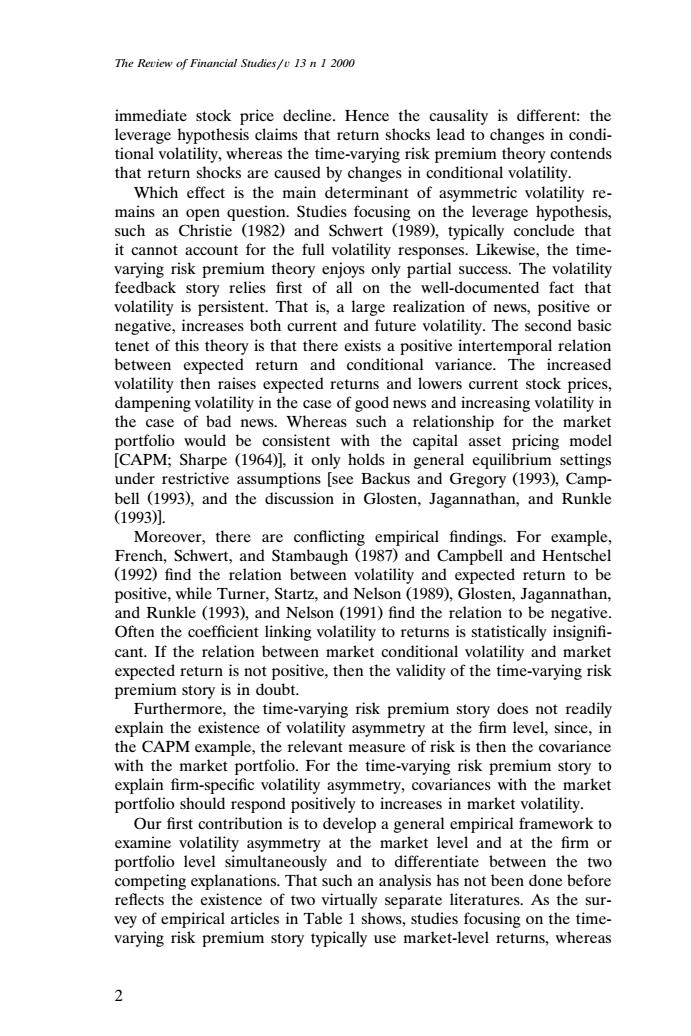正在加载图片...

The Review of Financial Studies/v 13 n 1 2000 immediate stock price decline.Hence the causality is different:the leverage hypothesis claims that return shocks lead to changes in condi- tional volatility,whereas the time-varying risk premium theory contends that return shocks are caused by changes in conditional volatility. Which effect is the main determinant of asymmetric volatility re- mains an open question.Studies focusing on the leverage hypothesis, such as Christie (1982)and Schwert (1989),typically conclude that it cannot account for the full volatility responses.Likewise,the time- varying risk premium theory enjoys only partial success.The volatility feedback story relies first of all on the well-documented fact that volatility is persistent.That is,a large realization of news,positive or negative,increases both current and future volatility.The second basic tenet of this theory is that there exists a positive intertemporal relation between expected return and conditional variance.The increased volatility then raises expected returns and lowers current stock prices, dampening volatility in the case of good news and increasing volatility in the case of bad news.Whereas such a relationship for the market portfolio would be consistent with the capital asset pricing model [CAPM;Sharpe (1964)],it only holds in general equilibrium settings under restrictive assumptions [see Backus and Gregory(1993),Camp- bell (1993),and the discussion in Glosten,Jagannathan,and Runkle (1993)1. Moreover,there are conflicting empirical findings.For example, French,Schwert,and Stambaugh (1987)and Campbell and Hentschel (1992)find the relation between volatility and expected return to be positive,while Turner,Startz,and Nelson (1989),Glosten,Jagannathan, and Runkle (1993),and Nelson (1991)find the relation to be negative. Often the coefficient linking volatility to returns is statistically insignifi- cant.If the relation between market conditional volatility and market expected return is not positive,then the validity of the time-varying risk premium story is in doubt. Furthermore,the time-varying risk premium story does not readily explain the existence of volatility asymmetry at the firm level,since,in the CAPM example,the relevant measure of risk is then the covariance with the market portfolio.For the time-varying risk premium story to explain firm-specific volatility asymmetry,covariances with the market portfolio should respond positively to increases in market volatility. Our first contribution is to develop a general empirical framework to examine volatility asymmetry at the market level and at the firm or portfolio level simultaneously and to differentiate between the two competing explanations.That such an analysis has not been done before reflects the existence of two virtually separate literatures.As the sur- vey of empirical articles in Table 1 shows,studies focusing on the time- varying risk premium story typically use market-level returns,whereas 2The Reiew of Financial Studies 13 n 1 2000 immediate stock price decline. Hence the causality is different: the leverage hypothesis claims that return shocks lead to changes in conditional volatility, whereas the time-varying risk premium theory contends that return shocks are caused by changes in conditional volatility. Which effect is the main determinant of asymmetric volatility remains an open question. Studies focusing on the leverage hypothesis, such as Christie 1982 and Schwert 1989 , typically conclude that Ž. Ž. it cannot account for the full volatility responses. Likewise, the timevarying risk premium theory enjoys only partial success. The volatility feedback story relies first of all on the well-documented fact that volatility is persistent. That is, a large realization of news, positive or negative, increases both current and future volatility. The second basic tenet of this theory is that there exists a positive intertemporal relation between expected return and conditional variance. The increased volatility then raises expected returns and lowers current stock prices, dampening volatility in the case of good news and increasing volatility in the case of bad news. Whereas such a relationship for the market portfolio would be consistent with the capital asset pricing model CAPM; Sharpe 1964 , it only holds in general equilibrium settings Ž . under restrictive assumptions see Backus and Gregory 1993 , Camp- Ž . bell 1993 , and the discussion in Glosten, Jagannathan, and Runkle Ž . Ž . 1993 . Moreover, there are conflicting empirical findings. For example, French, Schwert, and Stambaugh 1987 and Campbell and Hentschel Ž . Ž . 1992 find the relation between volatility and expected return to be positive, while Turner, Startz, and Nelson 1989 , Glosten, Jagannathan, Ž . and Runkle 1993 , and Nelson 1991 find the relation to be negative. Ž. Ž. Often the coefficient linking volatility to returns is statistically insignifi- cant. If the relation between market conditional volatility and market expected return is not positive, then the validity of the time-varying risk premium story is in doubt. Furthermore, the time-varying risk premium story does not readily explain the existence of volatility asymmetry at the firm level, since, in the CAPM example, the relevant measure of risk is then the covariance with the market portfolio. For the time-varying risk premium story to explain firm-specific volatility asymmetry, covariances with the market portfolio should respond positively to increases in market volatility. Our first contribution is to develop a general empirical framework to examine volatility asymmetry at the market level and at the firm or portfolio level simultaneously and to differentiate between the two competing explanations. That such an analysis has not been done before reflects the existence of two virtually separate literatures. As the survey of empirical articles in Table 1 shows, studies focusing on the timevarying risk premium story typically use market-level returns, whereas 2����